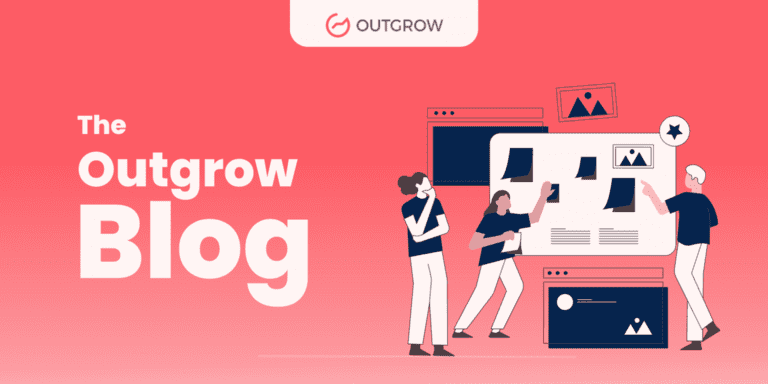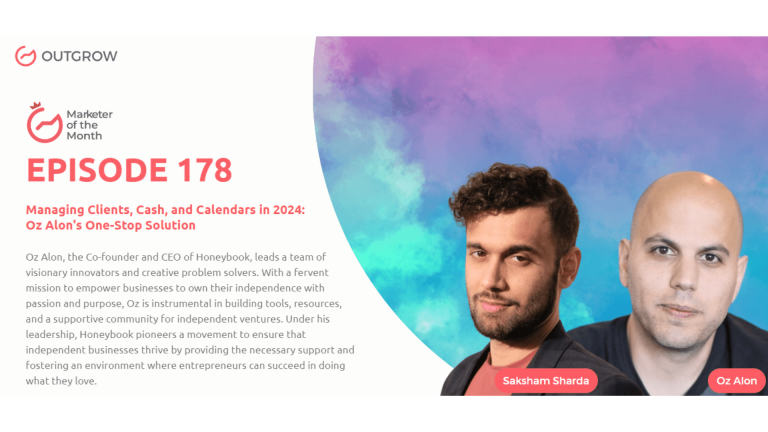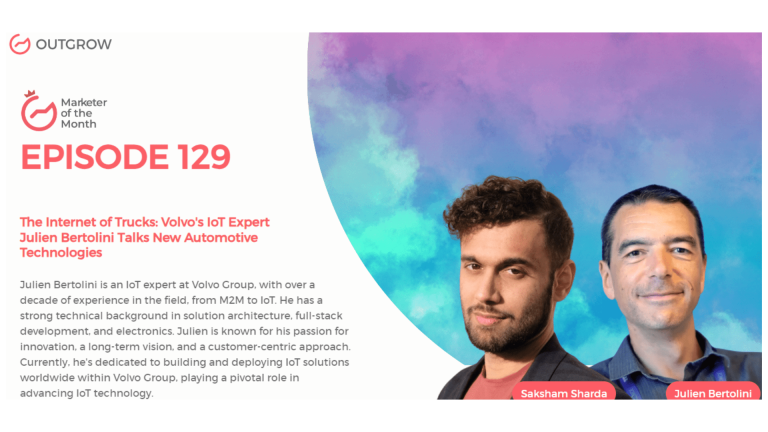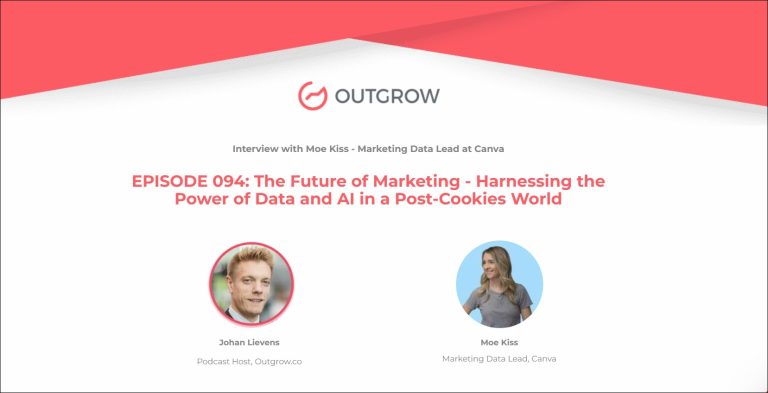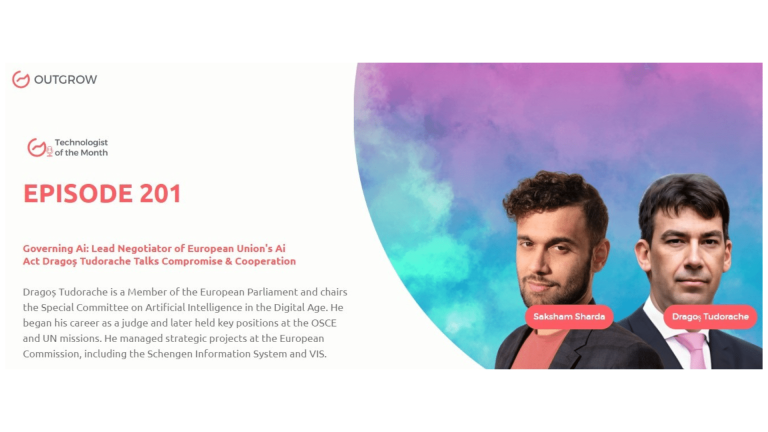EPISODE 217: Marketer of the Month Podcast with Phil Wiser
Table of Contents
Hey there! Welcome to the Marketer Of The Month blog!
We recently interviewed Phil Wiser for our monthly podcast – ‘Marketer of the Month’! We had some amazing insightful conversations with Phil and here’s what we discussed about –
1. Discussion about AI shaping Paramount’s technology initiatives.
2. How AI enhances content targeting and personalization for marketing.
3. Identifying areas where AI could disrupt the media industry positively.
4. Ensuring that human judgment remains central in AI-driven marketing.
5. Lessons from Liquid Audio and Sezmi about timing and innovation in media.
6. The nuanced future of media distribution, balancing direct-to-consumer models and partnerships with other platforms.
7. Comparing the slow decline of traditional pay TV to the rapid collapse of CD sales in the music industry.
About our host:
Dr. Saksham Sharda is the Chief Information Officer at Outgrow.co. He specializes in data collection, analysis, filtering, and transfer by means of widgets and applets. Interactive, cultural, and trending widgets designed by him have been featured on TrendHunter, Alibaba, ProductHunt, New York Marketing Association, FactoryBerlin, Digimarcon Silicon Valley, and at The European Affiliate Summit.
About our guest:
Phil Wiser is the Executive Vice President and Chief Technology Officer at Paramount Global, leading the company’s AI-first technology strategy across content creation, infrastructure, and broadcast operations. With prior leadership roles at Hearst and Sony, Phil has pioneered digital media innovations, including cloud migration and machine learning. His expertise in IP-based content delivery and cybersecurity drives Paramount’s technological advancements in the media industry.
Streaming the Future: Paramount’s CTO Phil Wiser on AI’s Creative Edge in the Media Market
The Intro!
Saksham Sharda: Hi, everyone. Welcome to another episode of Outgrow’s Marketer of the Month. I’m your host, Dr. Saksham Sharda, and I’m the creative director at Outgrow. co. And for this month we are going to interview Phil Wiser who is the Executive Vice President and Chief Technology Officer at Paramount Global.
Phil Wiser: Great to be here. Thank you.
Don’t have time to read? No problem, just watch the Podcast!
Challenge yourself with this trivia about the exciting topics Phil Wiser covered in the podcast.
Or you can just listen to it on Spotify!
The Rapid Fire Round!
Saksham Sharda: Let’s start with the rapid-fire round to break the ice. The first question is at what age do you want to retire?
Phil Wiser: Never.
Saksham Sharda: How long does it take you to get ready in the mornings?
Phil Wiser: 20 minutes.
Saksham Sharda: Favorite colour?
Phil Wiser: Blue.
Saksham Sharda: What time of day are you most inspired?
Phil Wiser: 6 a.m.
Saksham Sharda: How many hours of sleep can you survive on?
Phil Wiser: Five.
Saksham Sharda: Fill in the blank. An upcoming technology trend is ____.
Phil Wiser: The AI trend is very real.
Saksham Sharda: The city in which the best kiss of your life happened?
Phil Wiser: San Francisco.
Saksham Sharda: Pick one. Mark Zuckerberg or Jack Dorsey?
Phil Wiser: Neither.
Saksham Sharda: The biggest mistake of your career?
Phil Wiser: Too early on streaming TV.
Saksham Sharda: How do you relax?
Phil Wiser: Play music.
Saksham Sharda: How many cups of coffee do you drink per day?
Phil Wiser: Way too many.
Saksham Sharda: A habit of yours that you hate?
Phil Wiser: Fidgeting.
Saksham Sharda: The most valuable skill you’ve learned in life?
Phil Wiser: Patience.
Saksham Sharda: Your favorite OTT show?
Phil Wiser: Star Trek Strange New Worlds.
Saksham Sharda: One-word description of your leadership style?
Phil Wiser: Inclusive.
Saksham Sharda: Top priority in your daily schedule?
Phil Wiser: Thinking.
Saksham Sharda: Ideal vacation spot for relaxation?
Phil Wiser: I would say just the beach in general.
The Big Questions!
Saksham Sharda: Let’s go on to the longer questions, which you can answer with as much ease or time as you like. The first is how has Paramount Global’s AI-first approach shaped the company’s overall technology strategy?
Phil Wiser: Well, I think we’ve been very pragmatic with our approach to AI. We recognized very early on, and we’ve been doing this for over seven years, that AI had great application to obvious things, like content recommendations and processing. But, from 2022 onward, we saw this great next phase of AI, and our approach there was to partner with the leading technology companies who are building the top foundation models or exposing those capabilities to products and tools that we already use. So we did a partnership with Adobe to make sure that we could empower our many thousands of editorial creatives to use AI in their day. And that idea of educating our teams, giving them tools today that enabled them to use the technology and then seeing what comes out of it, that running of that experiment we found to be very successful and also cost-effective. And it gives us the ability to adapt as this AI wave continues to take different shapes.
Saksham Sharda: And are there any challenges that you’ve faced in fostering this AI-centric culture at such a large-scale company?
Phil Wiser: The biggest challenge with AI has been the fear. And that fear, in some cases, is valid. In most cases, it’s not valid. So we’ve had to do a lot of education awareness. In many cases, it was simply getting those who had concerns, getting them to use the technology, and learning very quickly where it could help them. And also, I think, mostly learning its limitations. Because there’s been a false narrative that somehow AI is going to create a TV show or it’s going to create a movie. You just need to use it virtually to learn very quickly. That is not the case. And it can do some relatively small things to help you in that process. So to me, the fear of overcoming that through education has been the biggest challenge.
Saksham Sharda: So speaking of this cycle of AI innovation, if one were to look back at your time as founder of Liquid Audio and Sezmi, how did those pioneering efforts shape your perspective on media innovation today?
Phil Wiser: Well, both of those recognized what was about to come. And primarily, in terms of internet distribution of media. With Liquid Audio, we saw the convergence of trends in technology between the compression of audio using things like MP3 and then the scale of the internet. We saw that technology convergence would enable a new consumer experience. And we were right. But both with Liquid Audio and even more so with SESME, the thing that we got wrong, I think, in SESME, was just timing. We did everything else right. We built the first recommendation system built into the TV system. Many other things that could go on that we did right. But we had expected the market to shift dramatically in pay TV in around 2010. And it didn’t even start to move significantly until five or more years later. So I think the thing I learned in all of that is to be a bit patient, even when you see an obvious trajectory for the industry. Be realistic about timing. And there are many factors, primarily economic factors, that you have to take into account before you get to the ultimate market. And that’s now playing out in the TV space with quickly approaching a point where the majority of all viewing is going to be coming over an internet-distributed product.
Saksham Sharda: So if you were to start a media-tech company today, what areas of innovation would you focus on?
Phil Wiser: Well, obviously, I would try to identify a market opportunity that could be disrupted through AI. And I don’t say that, like many of the startups that are just saying they’re an AI company, they have to find an area that can meaningfully be disrupted positively with the application of AI. And there are many of those. And obviously, the funding level for new innovative startups is pretty dramatic. But similar to the internet bubble, we are going to go through the AI bubble, where many of these companies are very shallow, and they’re thinking about the application of AI and maybe have a feature versus a full company. But I’ve got several ideas, I always do, about areas where I think there’s some big opportunities, you know, applying AI to build a new, better business around media.
Saksham Sharda: And so coming back to Paramount, then how do you see AI transforming marketing strategies at Paramount, particularly in terms of targeting and personalizing content for global audiences?
Phil Wiser: I think that marketing is one of the areas that will have the most benefit from AI now. And there are a couple of reasons for that. One is that most of the content that’s produced for marketing purposes is derivative from existing content. AI is good at taking existing content, transforming it, and modifying it. So our marketing teams have embraced that, as they try to create targeted content to hit different channels or different demographics and produce more content to feed into the multitude of channels they have to reach consumers now. So I feel like marketing is already the area where we’re making the most progress in terms of the use of AI, and I think that that will continue. The big question for the industry is whether that means we’re more effective with our marketing, or even more efficient. I think we’ll have to wait and see whether that plays out. But I do think we’re going to have better, more targeted, and certainly get some more interesting campaigns coming out of the widespread use of AI.
Saksham Sharda: And how do you ensure that AI-driven marketing remains authentic and avoids oversaturation of personalized content?
Phil Wiser: Well, that’s why you have people doing it. So really, it’s a key element of this discussion around AI is that there always has to be a human in the room. There is a judgment, there is an awareness of the world and context that we need humans to be in there using this as it is. It’s a tool. The judgment that comes in the content that’s being created and what’s going out into the world still very much sits in the hands of the creatives. So I think as long as we’ve got the right creatives in the room, we won’t run into that problem.
Saksham Sharda: So as a pioneer of digital music and OTT TV, how do you see the future of IP-based content delivery evolving?
Phil Wiser: Can I just ask you to clarify that? So when you say IP-based content delivery, do you mean the technical distribution of it or just the internet distribution generally?
Saksham Sharda: Technical.
Phil Wiser: Well, I think the current model that’s been built up around content delivery networks sitting on the edge and is working across multiple content delivery networks, will continue. But I think the scale of the cloud fabric that’s covering the globe with the hyperscalers now, that’s going to become more and more capable of really doing all of the delivery that we need. So I do expect that just the architecture, the network architecture in particular, is going to change to be much simpler as more and more kinds of global computing move into these public cloud models.
Saksham Sharda: So your background spans both digital music and media at Sony and Hearst. How have those experiences influenced your approach to all this at Paramount?
Phil Wiser: Well, I think the experience with music, seeing that industry goes from one that was very stable on a single media model, namely compact discs at the time I entered it with technology, seeing it move from that stable model, go through the disruption and kind of destruction of the business, and come out the other side with a new model built around wide-scale streaming, that gave me kind of a longer view in terms of other media markets and how those would evolve.And I dealt with that on the print side of the business when I was at Hearst, obviously dealing with that now in the context of television and CBS and the broader Paramount. So it just gave me that longer-term view to look at the arc of this transition of the industry and make sure we’re well positioned, but we don’t panic and have a bit of pragmatism about how quickly things will move.
Saksham Sharda: So who do you think are the biggest winners and losers from the music transition, and who will be the biggest winners and losers from the upcoming media transition?
Phil Wiser: Well, I think in the music transition, consumers are huge winners. The amount of content you have access to now is something you could not imagine in the mid-90s before all of this happened. At that point, you still had to spend $10 to $20 to buy 10 to 20 songs, and that was it. You played those over and over again, and it was very limited outside of radio in terms of your access to music, and now it’s unlimited. So I think from a consumer perspective, that’s all positive. And I think it’s great for artists as well. When I started Liquid Audio, a driver for that company was as much helping the artists as the consumer, because, at that moment, it was very hard for anyone other than large stars to break through because you had all this friction with producing bits of plastic and how you sent that out into the world.
So I do feel like artists now, even though their lives are very different, there’s a lot more noise in the market, and you have an opportunity to reach an audience. Even if it’s a smaller audience, you can build a business around that or build a lifestyle around that in music in a way that was impossible 30 years ago. The other thing I would say in terms of the internet in general, the fact that you’ve got so many artists that are performing live now and finding an audience, sometimes it’s an old audience, that also would have been impossible 30 years ago because it would have been very hard to aggregate people that are distributed in a very targeted fan base, but now you can do that. I think it’s been great for artists. Their careers are extended because of what the internet has brought to the music industry.
Saksham Sharda: And so what way does that apply to the future of film and TV?
Phil Wiser: Well, I think it’s a little bit different because you’ve got several franchises that have this kind of installed fan base. But generally, television is a bit more ephemeral, traditionally. And then, as we saw in the evolution of television, shows that would disappear got more life through syndication, which was a breakthrough model 50 years ago to start redistributing and replaying this content. And what we’re seeing now is it shows that maybe even 50-year-olds are getting new life. So I think it’s a similar model where the extension and expansion of franchises is playing out because now you’ve got so much access. And I’d be curious to see if it is the same sort of model where some of these franchises can live on for many years beyond what would have been feasible before a streaming model. The unknown thing is how this plays out in such a noisy environment. As it is, as we all know, using streaming services is very hard to find the content you want to watch. And that will get better. I do think that AI will play a role in making that easier and helping you navigate to something or talk your way to something that you want to watch. But I think it will also continue to add more and more value to the back catalogue of companies like Paramount. And that’s one reason that we were very actively making sure that our archives and our broader collection of assets are readily available to be licensed or distributed through streaming throughout the world.
Saksham Sharda: So if you had to look back at it, what was your vision when driving Hearst’s transition to a cloud-first environment? And how did it reshape the company’s digital strategy?
Phil Wiser: Well, the push at Hearst was early in the cloud transition. That was about 2012. And there were scale, moderately scaled, I would say, cloud providers with Amazon being the leading provider. And the vision when I came into that company was really to give them a core shared technical capability. When I joined Hurst, they had no shared common technical foundation at all. So moving to the cloud gave us a common architecture on which we could build. And when we have that common architecture, then we can build new opportunities in digital. So it accelerated our digital ambitions and made them more refreshed, if you will, relative to what came before that. When I joined the company, the digital model was to take a magazine, turn it into a very high-quality PDF effectively, and put it on an iPad. So it was sort of similar to the early movies being someone just putting a camera in front of a stage and recording a play. And moving to the cloud enabled us to innovate, generate a lot more content, and make sure that it was something that played well on the internet. And then when social became more and more of a platform, and in particular, I remember when Evan came in and talked about this new service called Snapchat, and we were able to jump on that and build up one of the better-branded experiences within the Snapchat environment when that got off the ground.
Saksham Sharda: So in hindsight, what would you have done differently during this cloud migration process? And how do you bring that hindsight to Paramount now?
Phil Wiser: Well, I did learn from that. So when I joined Paramount, I took the learnings from the Hearst migration and applied that to how we approach things in Paramount. And if anything, it just gave me more confidence that this was the right direction to move. The thing that I learned, and that we did put in place at Paramount, was to make sure that we had a strong commitment from the cloud providers. So we did a very important strategic partnership with AWS, Amazon’s web services division. We got buy-in not only from our CEO at the time, Bob Backish, but Andy Jassy, who was the CEO of Amazon Web Services at that time. We got them to both commit to this transition because it is a big change. And we had to do a lot of work to not only educate but also retool our technology teams to be cloud-first. And that took commitment to the top.
Saksham Sharda: So how do you align all these technology initiatives with Paramount’s broader business objectives to ensure long-term growth and innovation?
Phil Wiser: Well, the key thing that I bring to the role is experience running all aspects of a media business, which I did in both of my startup businesses, really understanding what it means to produce content, to license it, and then also to sell it. And that sort of broad view informs everything that I do from a technology perspective. I think a key thing is just the guiding principle. We as technologists are here to serve the content. It’s not the other way around. So when people say, oh, we’re gonna be a technology and media company, what they’re saying is we wanna make sure we can adapt to these new distribution models. But we have to keep in mind that we are a media company, we’re a content company first. And bringing that kind of ethos to the role and then how our team operates, I think keeps us emotionally and then overall aligned with the business.
Saksham Sharda: So do you think the future of media companies is also technology slash media companies?
Phil Wiser: Look, I think that technology is increasingly important and a key driver for all companies. And when you look at any stats related to how much technology is taking the load of operating businesses, it just increases every year. We should be thankful for that because when we, unfortunately, went through a pandemic, the fact that we could all go home and work seamlessly was a result of depending on technology to connect us, to drive our work daily. And that has stuck with us. So it’s one thing that I have to battle because I’m inside of a company running a technology function. I have to battle the misunderstanding that technology costs tend to grow, but then you have to look at those technology costs growing in the context of how much of the business is running on that. And if you look at it over time, it’s a dramatically larger portion of the overall business is now running on core computing and networking technologies.
Saksham Sharda: So speaking of the pandemic then, has Paramount seen a big difference in affinity towards OTT platforms as opposed to theatre, movie-going, and cinema?
Phil Wiser: Well, we’re just living through the same transition everyone else is, where we see the streaming businesses growing rapidly, the traditional pay TV on a gradual decline. And we’re hopeful that theatrical continues to rebound from the COVID era. And we’re investing in that and putting out top-notch theatrical content to support it. But I don’t think we’re very different than other major media companies in terms of navigating the transition, which as I’ve said, it’s hard to predict how all of this is gonna land in terms of that streaming distribution. And I do expect it to be more nuanced than most people will write about because it’s not binary in terms of how that distribution model is gonna play out. And I just talked about that on a panel with the head of technology for Amazon Prime Video, where we recognize that in some cases, we’re both going direct to consumers. In many cases, we’re going to the consumer together. And I think we just have to accept that reality. It’s gonna be a bit more complicated.
Saksham Sharda: So which avenue of media distribution will see the same future as a compact disc went through if it’s not theatre then?
Phil Wiser: Well, the compact disc was unique in that an entire industry was relying on selling one specific product format. So it’s very narrow. So I think clearly, traditional pay TV is gonna continue to decline. I think we’ve already seen, certainly, in the US market, satellite television going down even faster simply because the end-user experience requires a type of equipment that’s no longer necessary. So I do think traditional pay TV will continue to decline, but nothing in the TV ecosystem is gonna fall off as rapidly as CDs do. I mean, those declines, when I joined Sony Music in 2021, the industry was shrinking on CD sales by about 20 to 30% per year. So radical shift, as I said, that happened over a matter of five years. Television is gonna be on a much slower shift.
Saksham Sharda: Right, so the last question for you is of a personal kind. What would you be doing in your life if not this?
Phil Wiser: I’d be playing music every day.
Let’s Conclude!
Saksham Sharda: Thanks, everyone for joining us for this month’s episode of Outgrow’s Marketer of the Month. That was Phil Wiser who is the Executive Vice President and Chief Technology Officer at Paramount Global.
Phil Wiser: Pleasure. Thanks for having me.
Saksham Sharda: Check out the website for more details and we’ll see you once again next month with another marketer of the month.
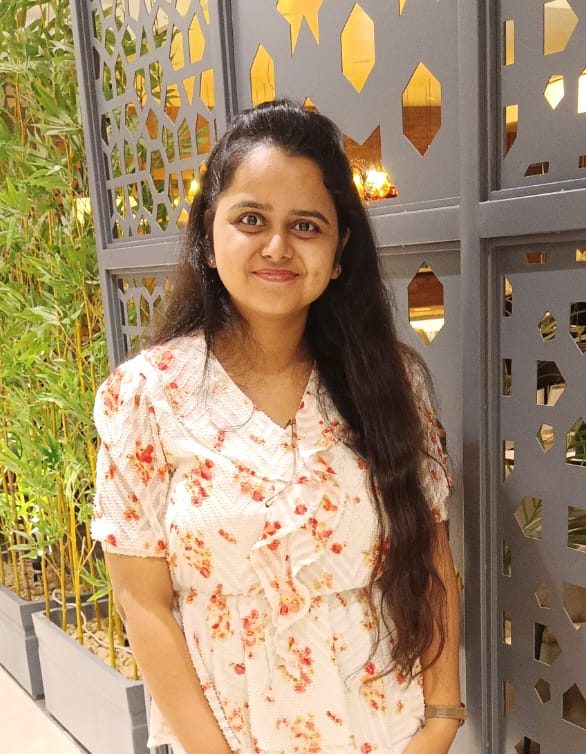
Muskan is a Marketing Analyst at Outgrow. She is working on multiple areas of marketing. On her days off though, she loves exploring new cafes, drinking coffee, and catching up with friends.





